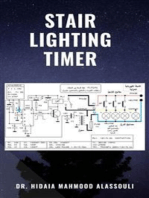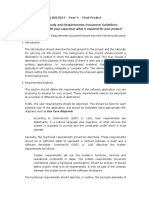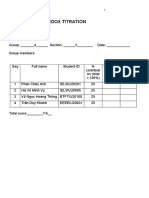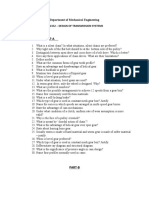Controllogix Voltage/Current Input Module: Installation Instructions
Controllogix Voltage/Current Input Module: Installation Instructions
Uploaded by
Marco RojasCopyright:
Available Formats
Controllogix Voltage/Current Input Module: Installation Instructions
Controllogix Voltage/Current Input Module: Installation Instructions
Uploaded by
Marco RojasOriginal Title
Copyright
Available Formats
Share this document
Did you find this document useful?
Is this content inappropriate?
Copyright:
Available Formats
Controllogix Voltage/Current Input Module: Installation Instructions
Controllogix Voltage/Current Input Module: Installation Instructions
Uploaded by
Marco RojasCopyright:
Available Formats
Installation Instructions
ControlLogix
Voltage/Current Input Module
(Catalog Number 1756-IF16)
To:
See page:
Obtain a User Manual
Identify the Module Components
Prevent Electrostatic Discharge
See Removal and Insertion Under Power (RIUP)
Understand Compliance to European Union Directive
Note the Power Requirements
Install the Module
Key the Removable Terminal Block/Interface Module
Wire the Module
Assemble the Removable Terminal Block and the Housing
12
Install the Removable Terminal Block onto the Module
12
Check the Indicators
14
Remove the Removable Terminal Block from the Module
15
Remove the Module
16
See 1756-IF16 Specifications
16
Hazardous Location information
18
Obtain a User Manual
This product also has a user manual (pub. no. 1756-6.5.9). To view it,
visit www.ab.com/manuals or www.theautomationbookstore.com
You can also purchase a printed manual by:
contacting your local distributor or Rockwell Automation
representative
visiting www.theautomationbookstore.com and placing
an order
Publication 1756-IN039C-EN-P - October 2000
2 ControlLogix Voltage/Current Input Module
calling 800.963.9548 (USA/Canada) or 001.320.725.1574
(outside USA/Canada)
Identify the Module Components
You received the following components with your order:
1756-IF16 module
Removable Terminal Block (RTB) door label
If you did not receive these components, contact your Rockwell
Automation sales office.
This module mounts in a ControlLogix chassis and uses a
separately-ordered RTB or a Bulletin 1492 Interface Module (IFM) to
connect all field-side wiring.
This module uses one of the following RTBs:
1756-TBCH 36 position Cage clamp RTB
1756-TBS6H 36 position Spring clamp RTB
Use an extended-depth cover (1756-TBE) for applications with heavy
gauge wiring or requiring additional routing space. When using an
IFM, consult the documentation that came with it to connect
all wiring.
IMPORTANT
Before you install your module, you should
have already:
installed and grounded a 1756 chassis and
power supply.
ordered and received an RTB or IFM and its
components for your application.
Publication 1756-IN039C-EN-P - October 2000
ControlLogix Voltage/Current Input Module 3
Prevent Electrostatic Discharge
ATTENTION
Electrostatic discharge can damage integrated circuits or
semiconductors if you touch backplane connector pins.
Follow these guidelines when you handle the module:
Touch a grounded object to discharge
static potential.
Wear an approved wrist-strap grounding device.
Do not touch the backplane connector or connector
pins.
Do not touch circuit components inside the module.
If available, use a static-safe work station.
When not in use, keep the module in its static-shield
box.
Removal and Insertion Under Power (RIUP)
WARNING
This module is designed so you can remove and insert it
under backplane power and field-side power. When you
remove or insert a module while field-side power is
applied, you may cause an electrical arc. An electrical
arc can cause personal injury or property damage
because it may:
send an erroneous signal to your systems field
devices, causing unintended machine motion or loss
of process control.
cause an explosion in a hazardous environment.
Repeated electrical arcing causes excessive wear to
contacts on both the module and its mating connector.
Worn contacts may create electrical resistance.
When you insert or remove the module while backplane
power is on, or you connect or disconnect the RTB with
field-side power applied, an electrical arc can occur. This
could cause an explosion in hazardous location
installations. Be sure that power is removed or the area is
non-hazardous before proceeding.
Publication 1756-IN039C-EN-P - October 2000
4 ControlLogix Voltage/Current Input Module
Understand Compliance to European Union Directive
If this product bears the CE marking, it is approved for installation
within the European Union and EEA regions. It has been designed
and tested to meet the following directives.
EMC Directive
This product is tested to meet Council Directive 89/336/EEC
Electromagnetic Compatibility (EMC) and the following standards, in
whole or in part, documented in a technical construction file:
EN 50081-2 EMC - Generic Emission Standard, Part 2 Industrial Environment
EN 50082-2 EMC - Generic Immunity Standard, Part 2 Industrial Environment
This product is intended for use in an industrial environment.
Low Voltage Directive
This product is tested to meet Council Directive 73/23/EEC Low
Voltage, by applying the safety requirements of EN 61131-2
Programmable Controllers, Part 2 - Equipment Requirements and
Tests.
For specific information required by EN 61131-2, see the appropriate
sections in this publication, as well as the following Allen-Bradley
publications:
Industrial Automation Wiring and Grounding Guidelines,
publication 1770-4.1
Automation Systems Catalog, publication B111
This equipment is classified as open equipment and must be installed
(mounted) in an enclosure during operation as a means of providing
safety protection.
Publication 1756-IN039C-EN-P - October 2000
ControlLogix Voltage/Current Input Module 5
Note the Power Requirements
This module receives power from the 1756 chasis power supply and
requires 2 sources of power from the backplane:
150mA at 5.1V dc
65mA at 24V dc
Add this current/power value (2.33W) to the requirements of all other
modules in the chassis to prevent overloading the power supply.
Install the Module
You can install or remove the module while chassis power is applied.
ATTENTION
The module is designed to support Removal and
Insertion Under Power (RIUP). However, when
you remove or insert an RTB with field-side power
applied, unintended machine motion or loss of
process control can occur. Exercise extreme
caution when using this feature.
1. Align circuit board with top and
bottom chassis guides.
2. Slide module into chassis until
module locking tabs click.
Locking tab
Printed
Circuit
Board
20861M
20862M
Publication 1756-IN039C-EN-P - October 2000
6 ControlLogix Voltage/Current Input Module
Key the Removable Terminal Block/Interface Module
Wedge-shaped keying tabs and U-shaped keying bands came with
your RTB to prevent connecting the wrong wires to your module.
Key positions on the module that correspond to unkeyed positions
on the RTB. For example, if you key the first position on the module,
leave the first position on the RTB unkeyed.
Key the Module
Key the RTB/IFM
1. Insert the U-shaped band as shown.
2. Push the band until it snaps in place.
1. Insert the wedge-shaped tab with rounded edge first.
2. Push the tab until it stops.
Wedge-shaped tab
U-shaped
bands
20850M
20851M
Reposition the tabs to rekey future module applications.
Wire the Removable Terminal Block
Wire the RTB with a 1/8 inch (3.2mm) maximum flat-bladed
screwdriver before installing it onto the module.
Shielded cable is required when using this module. We recommend
using Belden 8761 cable to wire the RTB. The RTB terminations can
accommodate 14-22 gauge shielded wire.
Connect grounded end of the cable
1. Ground the drain wire.
IMPORTANT
We recommend grounding the drain wire at the
field-side. If you cannot ground at the field-side, ground
at an earth ground on the chassis as shown.
Publication 1756-IN039C-EN-P - October 2000
ControlLogix Voltage/Current Input Module 7
A. Remove a length
of cable jacket
from the
connecting cable.
B. Pull the foil shield
and bare drain
wire from the
insulated wire.
C. Twist the foil shield
and drain wire
together to form a
single strand.
D. Attach a ground lug
and apply heat
shrink tubing to the
exit area.
20104-M
E. Connect the drain wire to a
chassis mounting tab.
4M or 5M (#10 or #12)
star washer
Use any chassis mounting
tab that is designated as a
functional signal ground.
4M or 5M (#10 or #12)
phillips screw and star
washer (or SEM screw)
Chassis mounting tab
Drain wire with ground lug
20918-M
2. Connect the insulated wires to the field-side.
Connect ungrounded end of the cable
1. Cut the foil shield and drain wire back to the cable casing and
apply shrink wrap.
2. Connect the insulated wires to the RTB.
Spring Clamp RTB
A. Strip 7/16 inch (11mm) maximum
length of wire.
B. Insert the screwdriver into the inner
hole of the RTB.
C. Insert the wire into the open
terminal and remove the
screwdriver.
20860-M
Cage Clamp RTB
A. Strip 3/8 inch (9.5mm) maximum length
of wire.
B. Insert the wire into the open terminal.
C. Turn the screw clockwise to close the
terminal on the wire.
20859-M
Publication 1756-IN039C-EN-P - October 2000
8 ControlLogix Voltage/Current Input Module
Wire the Module
You can only connect wiring to your module through an RTB or IFM.
The example below shows how to wire the module.
1756-IF16 Differential current wiring example
Channel 0
i
A
Shield
ground
Channel 3
2-Wire
Transmitter
i
A
IN-0
i RTN-0
IN-1
i RTN-1
IN-2
i RTN-2
IN-3
i RTN-3
RTN
10
RTN
IN-4
12 11
i RTN-4
IN-5
14 13
i RTN-5
IN-6
16 15
i RTN-6
IN-7
18 17
i RTN-7
IN-8
20 19
i RTN-8
IN-9
22 21
i RTN-9
IN-10
24 23
i RTN-10
IN-11
26 25
i RTN-11
RTN
28 27
RTN
IN-12
30 29
i RTN-12
IN-13
32 31
i RTN-13
IN-14
34 33
i RTN-14
IN-15
36 35
i RTN-15
Jumper
wires
40912-M
NOTES: 1. Use the following chart when wiring your module in differential mode
This channel:
Uses these terminals:
This channel:
Uses these terminals:
Channel 0
IN-0 (+), IN-1 (-) & i RTN-0
Channel 4
IN-8 (+), IN-9 (-) & i RTN-8
Channel 1
IN-2 (+), IN-3 (-) & i RTN-2
Channel 5
IN-10 (+), IN-11 (-) & i RTN-10
Channel 2
IN-4 (+), IN-5 (-) & i RTN-4
Channel 6
IN-12 (+), IN-13 (-) & i RTN-12
Channel 3
IN-6 (+), IN-7 (-) & i RTN-6
Channel 7
IN-14 (+), IN-15 (-) & i RTN-14
2.
3.
4.
5.
When operating in 4 channel, high speed mode, only use channels 0, 2, 4 and 6.
All terminals marked RTN are connected internally.
A 249 current loop resistor is located between IN-x and i RTN-x terminals.
If multiple (+) or multiple (-) terminals are tied together, connect that tie point to a RTN
terminal to maintain the modules accuracy.
6. Place additional loop devices (e.g. strip chart recorders, etc.) at either A location.
7. If separate power sources are used, do not exceed the specified isolation voltage.
Publication 1756-IN039C-EN-P - October 2000
ControlLogix Voltage/Current Input Module 9
1756-IF16 Differential voltage wiring example
Channel 0
Shield ground
Channel 3
Shield ground
IN-0
i RTN-0
IN-1
i RTN-1
IN-2
i RTN-2
IN-3
i RTN-3
RTN
10
RTN
IN-4
12 11
i RTN-4
IN-5
14 13
i RTN-5
IN-6
16 15
i RTN-6
IN-7
18 17
i RTN-7
IN-8
20 19
i RTN-8
IN-9
22 21
i RTN-9
IN-10
24 23
i RTN-10
IN-11
26 25
i RTN-11
RTN
28 27
RTN
IN-12
30 29
i RTN-12
IN-13
32 31
i RTN-13
IN-14
34 33
i RTN-14
IN-15
36 35
i RTN-15
40913-M
NOTES: 1. Use the following chart when wiring your module in differential mode
This channel:
Uses these terminals:
This channel:
Uses these terminals:
Channel 0
IN-0 (+) & IN-1 (-)
Channel 4
IN-8 (+) & IN-9 (-)
Channel 1
IN-2 (+) & IN-3 (-)
Channel 5
IN-10 (+) & IN-11 (-)
Channel 2
IN-4 (+) & IN-5 (-)
Channel 6
IN-12 (+) & IN-13 (-)
Channel 3
IN-6 (+) & IN-7 (-)
Channel 7
IN-14 (+) & IN-15 (-)
2. When operating in 4 channel, high speed mode, only use channels 0, 2, 4 and 6.
3. All terminals marked RTN are connected internally.
4. If multiple (+) or multiple (-) terminals are tied together, connect that tie point to a RTN
terminal to maintain the modules accuracy.
5. Terminals marked RTN and i RTN are not used for differential voltage wiring.
6. If separate power sources are used, do not exceed the specified isolation voltage.
Publication 1756-IN039C-EN-P - October 2000
10 ControlLogix Voltage/Current Input Module
1756-IF16 Single-ended current wiring example
Shield ground
2-Wire
Transmitter
i
A
IN-0
i RTN-0
IN-1
i RTN-1
IN-2
i RTN-2
IN-3
i RTN-3
RTN
10
RTN
IN-4
12 11
i RTN-4
IN-5
14 13
i RTN-5
IN-6
16 15
i RTN-6
IN-7
18 17
i RTN-7
IN-8
IN-9
20 19
22 21
i RTN-8
i RTN-9
IN-10
24 23
i RTN-10
IN-11
26 25
i RTN-11
RTN
28 27
RTN
IN-12
30 29
i RTN-12
IN-13
32 31
i RTN-13
IN-14
34 33
i RTN-14
IN-15
36 35
i RTN-15
Jumper
wires
40914-M
NOTES: 1. All terminals marked RTN are connected internally.
2. A 249 current loop resistor is located between IN-x and i RTN-x terminals.
3. For current applications, all terminals marked i RTN must be wired to terminals
marked RTN.
4. Place additional loop devices (e.g. strip chart recorders, etc.) at either A location.
5. If separate power sources are used, do not exceed the specified isolation voltage.
Publication 1756-IN039C-EN-P - October 2000
ControlLogix Voltage/Current Input Module 11
1756-IF16 Single-ended voltage wiring example
Shield ground
Shield ground
IN-0
i RTN-0
IN-1
i RTN-1
IN-2
i RTN-2
IN-3
i RTN-3
RTN
10
RTN
IN-4
12 11
i RTN-4
IN-5
14 13
i RTN-5
IN-6
16 15
i RTN-6
IN-7
18 17
i RTN-7
IN-8
20 19
i RTN-8
IN-9
22 21
i RTN-9
IN-10
24 23
i RTN-10
IN-11
26 25
i RTN-11
RTN
28 27
RTN
IN-12
30 29
i RTN-12
IN-13
32 31
i RTN-13
IN-14
34 33
i RTN-14
IN-15
36 35
i RTN-15
40915-M
NOTES: 1. All terminals marked RTN are connected internally.
2. Terminals marked i RTN are not used for single-ended voltage wiring.
3. If separate power sources are used, do not exceed the specified isolation voltage.
After completing field-side wiring, secure the wires in the strain relief
area with a cable-tie.
Publication 1756-IN039C-EN-P - October 2000
12 ControlLogix Voltage/Current Input Module
Assemble the Removable Terminal Block and the Housing
1. Align the grooves at the bottom of the housing with the side edges of the RTB.
Groove
Side edge of the RTB
Groove
Strain relief area
Side edge of the RTB
2. Slide the RTB into the housing until it snaps into place.
20858M
Install the Removable Terminal Block onto the Module
WARNING
The RTB is designed to support Removal and Insertion
Under Power (RIUP). However, when you remove or
insert an RTB with field-side power applied, unintended
machine motion or loss of process control can
occur. Exercise extreme caution when using this feature.
It is recommended that field-side power be removed
before installing the RTB onto the module.
When you remove or insert a module while field-side
power is applied, you may cause an electrical arc. An
electrical arc can cause personal injury or property
damage because it may:
send an erroneous signal to your systems field
devices, causing unintended machine motion or loss
of process control.
cause an explosion in a hazardous environment.
Repeated electrical arcing causes excessive wear to
contacts on both the module and its mating connector.
Worn contacts may create electrical resistance.
When you insert or remove the module while backplane
power is on, or you connect or disconnect the RTB with
field-side power applied, an electrical arc can occur. This
could cause an explosion in hazardous location
installations. Be sure that power is removed or the area is
non-hazardous before proceeding.
Publication 1756-IN039C-EN-P - October 2000
ControlLogix Voltage/Current Input Module 13
Before installing the RTB, make certain:
field-side wiring of the RTB has been completed.
the RTB housing is snapped into place on the RTB.
the RTB housing door is closed.
the locking tab at the top of the module is unlocked.
1. Align the side and top, bottom RTB guides with the
side, top and bottom module guides.
Module
guide
RTB guides
20853M
2. Press quickly and evenly to seat the RTB on the
module until the latches snap into place.
Locking
tab
20854M
3. Slide the locking tab down to lock the RTB
onto the module.
Publication 1756-IN039C-EN-P - October 2000
14 ControlLogix Voltage/Current Input Module
Check the Indicators
The indicators show CAL status (green) and a bi-colored LED for
module "OK" (red/green).
ANALOG INPUT
CAL
OK
20962-M
During power up, an indicator test is done and the following occurs:
The "OK" indicator turns red for 1 second and then turns to
flashing green if it has passed the self-test.
LED
indicators:
This
display:
Means:
Take this action:
OK
Steady
green light
The inputs are being
multicast and in normal
operating state.
None
OK
Flashing
green light
The module has passed
internal diagnostics but is not
actively controlled.
Configure the module.
OK
Flashing red
light
Previously established
communication has timed out.
Check controller and chassis
communication
OK
Steady red
light
The module must be replaced.
Replace the module.
CAL
Flashing
green light
The module is in calibration
mode.
None
This completes installation of the module. Use the information below
to remove the module.
Publication 1756-IN039C-EN-P - October 2000
ControlLogix Voltage/Current Input Module 15
Remove the Removable Terminal Block from the Module
WARNING
Shock hazard exists. If the RTB is removed from
the module while the field-side power is applied,
the module will be electrically live. Do not touch
the RTBs terminals. Failure to observe this caution
may cause personal injury.
The RTB is designed to support Removal and
Insertion Under Power (RIUP). However, when
you remove or insert an RTB with field-side power
applied, unintended machine motion or loss of
process control can occur. Exercise extreme
caution when using this feature. It is
recommended that field-side power be removed
before removing the module.
When you insert or remove the module while
backplane power is on, or you connect or
disconnect the RTB with field-side power applied,
an electrical arc can occur. This could cause an
explosion in hazardous location installations. Be
sure that power is removed or the area is
non-hazardous before proceeding.
Before removing the module, you must remove the RTB.
1. Unlock the locking tab at the
top of the module.
2. Open the RTB door and pull the
RTB off the module.
42517
20855M
Publication 1756-IN039C-EN-P - October 2000
16 ControlLogix Voltage/Current Input Module
Remove the Module
1. Push in top and bottom locking tabs.
2. Pull module out of the chassis.
20856M
20857M
1756-IF16 Specifications
Number of Inputs
Module Location
Backplane Current
Power Dissipation within Module
Thermal Dissipation
Input Range and Resolution
Data Format
Input Impedance
Voltage
Current
Open Circuit Detection Time
Overvoltage Protection
Normal Mode Noise Rejection1
Common Mode Noise Rejection
16 single ended, 8 differential
or 4 differential (high speed)
1756 ControlLogix Chassis
150mA @ 5.1V dc & 65mA @ 24V dc
(Total backplane power2.33W)
2.3W voltage
3.9W current
7.84 BTU/hr voltage
13.30 BTU/hr current
+/-10.25V 320V/cnt (15 bits plus sign bipolar)
0-10.25V 160V/cnt (16 bits)
0-5.125V 80V/cnt (16 bits)
0-20.5mA 0.32A/cnt (16 bits)
Integer mode (Left justified, 2s complement)
Floating point IEEE 32 bit
>1meg
249
Differential voltage - Positive full scale reading
within 5s
Single Ended/Diff. current - Negative full scale
reading within 5s
Single Ended voltage - Even numbered channels go
to positive full scale reading within 5s, odd numbered
channels go to negative full scale reading within 5s
30V dc voltage
8V dc current
>80dB at 50/60Hz
>100dB at 50/60Hz
Publication 1756-IN039C-EN-P - October 2000
ControlLogix Voltage/Current Input Module 17
Calibrated Accuracy at 25C
Gain Drift with Temperature
Input Offset Drift with Temp.
Module Error over Full Temp.
Range
Module Scan Time for All
Channels
(Sample Rate Module Filter
Dependent)
Module Conversion Method
Isolation Voltage
User to system
RTB Screw Torque (Cage clamp)
Module Keying (Backplane)
RTB Keying
Field Wiring Arm and Housing
Environmental Conditions
Operating Temperature
Storage Temperature
Relative Humidity
Conductors
Wire Size
Category
Screwdriver Width for RTB
Agency Certification
(when product or
packaging is marked)
Better than 0.05% of range - voltage
Better than 0.15% of range - current
15 ppm/degree C - voltage
20 ppm/degree C - current
45V/degree C
0.1% of range - voltage
0.3% of range - current
16 pt single ended - 16-488ms
8 pt differential - 8-244ms
4 pt differential - 5-122ms
Sigma-Delta
100% tested at 2550 dc for 1s
4.4 inch-pounds (0.4Nm)
Electronic
User defined
36 Position RTB (1756-TBCH or TBS6H)2
0 to 60C (32 to 140F)
-40 to 85C (-40 to 185F)
5 to 95% noncondensing
22-14 gauge (2mm2) stranded 2
3/64 inch (1.2mm) insulation maximum
23, 4
1/8 inch (3.2mm) maximum
Listed Industrial Control Equipment
Certified Process Control Equipment
Certified Class I, Division 2, Group A, B, C, D
Approved Class I, Division 2, Group A, B, C, D
Marked for all applicable directives
Marked for all applicable acts
N223
1
2
3
4
This specification is module filter dependent.
Maximum wire size will require extended housing - 1756-TBE.
Use this conductor category information for planning conductor routing as described in the system
level installation manual.
Refer to publication 1770-4.1 Industrial Automation Wiring and Grounding Guidelines.
Publication 1756-IN039C-EN-P - October 2000
18 ControlLogix Voltage/Current Input Module
Additional Notes
The ControlLogix system must be mounted within a suitable enclosure to
prevent personal injury resulting from accessibility to live parts. The interior of
this enclosure must be accessible only by the use of a tool.
This industrial control equipment is intended to operate in a Pollution Degree
2 environment, in overvoltage category II applications, as defined in IEC
publication 664A, at altitudes up to 2000 meters without derating.
Hazardous Location information
The following information applies when operating this equipment in
hazardous locations:
Products marked CL I, DIV 2, GP A, B, C, D are suitable for use in Class I
Division 2 Groups A, B, C, D, Hazardous Locations and nonhazardous
locations only. Each product is supplied with markings on the rating
nameplate indicating the hazardous location temperature code. When
combining products within a system, the most adverse temperature code
(lowest T number) may be used to help determine the overall temperature
code of the system. Combinations of equipment in your system are subject to
investigation by the local Authority Having Jurisdiction at the time
of installation.
WARNING
EXPLOSION HAZARD
Do not disconnect equipment unless power has
been removed or the area is known to be
nonhazardous.
Do not disconnect connections to this equipment
unless power has been removed or the area is
known to be nonhazardous. Secure any external
connections that mate to this equipment by using
screws, sliding latches, threaded connectors, or
other means provided with this product.
Substitution of components may impair suitability
for Class I, Division 2.
If this product contains batteries, they must only be
changed in an area known to be nonhazardous.
Publication 1756-IN039C-EN-P - October 2000
ControlLogix Voltage/Current Input Module 19
Informations sur lutilisation de cet quipement en environnements
dangereux :
Les produits marqus CL I, DIV 2, GP A, B, C, D ne conviennent qu une
utilisation en environnements de Classe I Division 2 Groupes A, B, C, D
dangereux et non dangereux. Chaque produit est livr avec des marquages
sur sa plaque didentification qui indiquent le code de temprature pour les
environnements dangereux. Lorsque plusieurs produits sont combins dans
un systme, le code de temprature le plus dfavorable (code de temprature
le plus faible) peut tre utilis pour dterminer le code de temprature global
du systme. Les combinaisons dquipements dans le systme sont sujettes
inspection par les autorits locales qualifies au moment de linstallation.
AVERTISSEMENT
RISQUE DEXPLOSION
Couper le courant ou sassurer que lenvironnement
est class non dangereux avant de dbrancher
lquipement.
Couper le courant ou sassurer que lenvironnement
est class non dangereux avant de dbrancher les
connecteurs. Fixer tous les connecteurs externes
relis cet quipement laide de vis, loquets
coulissants, connecteurs filets ou autres moyens
fournis avec ce produit.
La substitution de composants peut rendre cet
quipement inadapt une utilisation en
environnement de Classe 1, Division 2.
Sassurer que lenvironnement est class non
dangereux avant de changer les piles.
Publication 1756-IN039C-EN-P - October 2000
Publication 1756-IN039C-EN-P - October 2000
Supersedes Publication 1756-5.39 - September 1999
PN 957424-67
2000 Rockwell International Corporation. Printed in USA
You might also like
- Commissioning Instructions Motormaster 200 Motor Protection RelaysDocument20 pagesCommissioning Instructions Motormaster 200 Motor Protection RelaysRinda_RaynaNo ratings yet
- En-12697-22-2003-Bituminous Mixtures Test Methods For Hot Mix Asphalt Part 22 Wheel TrackingDocument32 pagesEn-12697-22-2003-Bituminous Mixtures Test Methods For Hot Mix Asphalt Part 22 Wheel TrackingRabnawaz ImamNo ratings yet
- Installation And Maintenance Manual JOSLYN P/N 1455-85-M JOSLYN P/N 1455-85-MN Ac Power Arresters 208/120 VAC, 3φ, 4 WIRE, GROUNDED WYEDocument8 pagesInstallation And Maintenance Manual JOSLYN P/N 1455-85-M JOSLYN P/N 1455-85-MN Ac Power Arresters 208/120 VAC, 3φ, 4 WIRE, GROUNDED WYEsrogan2323No ratings yet
- Introduction to Power System ProtectionFrom EverandIntroduction to Power System ProtectionRating: 4 out of 5 stars4/5 (2)
- 18csc303j-Dbms Lab ManualDocument60 pages18csc303j-Dbms Lab ManualKiruthika SubramaniamNo ratings yet
- SUNTREE Series 5000TL 6000TL 8000TL Grid-Connected Inverter User Manual-EUDocument48 pagesSUNTREE Series 5000TL 6000TL 8000TL Grid-Connected Inverter User Manual-EUmtekpkNo ratings yet
- Type MCAG 14, 34: High Stability Circulating Current RelaysDocument30 pagesType MCAG 14, 34: High Stability Circulating Current Relaysrenjithas2005100% (2)
- Samsung Sync Master 940N LCD Service ManualDocument63 pagesSamsung Sync Master 940N LCD Service ManualFelix SemenNo ratings yet
- User Manual: Maxwell Technologies Ultracapacitor Energy Storage Modules For Heavy Duty Transportation ApplicationsDocument23 pagesUser Manual: Maxwell Technologies Ultracapacitor Energy Storage Modules For Heavy Duty Transportation Applicationsali alitharyNo ratings yet
- Abc of Power Modules: Functionality, Structure and Handling of a Power ModuleFrom EverandAbc of Power Modules: Functionality, Structure and Handling of a Power ModuleNo ratings yet
- Hookes LawDocument23 pagesHookes LawAman Singh100% (2)
- AB ControlLogixOutputModule 1756 OF8Document20 pagesAB ControlLogixOutputModule 1756 OF8QuynhtnNo ratings yet
- 1756 in 034 CenpDocument20 pages1756 in 034 CenpGuillermo LIZZANONo ratings yet
- 1756 Ib32Document16 pages1756 Ib32Daniel BacicNo ratings yet
- POINT I/O Common Terminal Module and Voltage Terminal ModuleDocument16 pagesPOINT I/O Common Terminal Module and Voltage Terminal Moduleluisllumiquinga97No ratings yet
- Ult REL Output Analog Modules 1734-In002 enDocument24 pagesUlt REL Output Analog Modules 1734-In002 enGabriel Constantin NastaseNo ratings yet
- POINT I/O Wiring Base Assembly: Environment and EnclosureDocument2 pagesPOINT I/O Wiring Base Assembly: Environment and EnclosureThanh BaronNo ratings yet
- Inversor Abb 2 5kwDocument2 pagesInversor Abb 2 5kwapi-290643326No ratings yet
- Compact 32-Point Solid-State 24V DC Source Output Module: Installation InstructionsDocument24 pagesCompact 32-Point Solid-State 24V DC Source Output Module: Installation InstructionsThanh BaronNo ratings yet
- 1769 Iq32tDocument20 pages1769 Iq32tHilder Ramirez PuellesNo ratings yet
- Deye Inverters ManualDocument39 pagesDeye Inverters ManualbirgauanNo ratings yet
- Imc-101g Hig 4eDocument15 pagesImc-101g Hig 4emrs.arporn22No ratings yet
- Files RELAYS ALSTOM P14 P14x-En-T-A22Document506 pagesFiles RELAYS ALSTOM P14 P14x-En-T-A22Mohamed ElmoghazyNo ratings yet
- ECX 400 SeriesDocument16 pagesECX 400 SeriesGeneral Electronic Facility LandsideNo ratings yet
- Micrologix™ Analog Input/Output: Installation InstructionsDocument24 pagesMicrologix™ Analog Input/Output: Installation InstructionsDavid LucioNo ratings yet
- Relay Block PDFDocument5 pagesRelay Block PDFJapheth K. KiptooNo ratings yet
- Installation Manual: JY997D33501DDocument3 pagesInstallation Manual: JY997D33501DDon Rodo Delgallagher100% (1)
- Bu6010 GB 0300Document44 pagesBu6010 GB 0300Kadirou BigstarNo ratings yet
- SH 4007 AhDocument398 pagesSH 4007 AhsmsbondNo ratings yet
- SH 4007 AiDocument398 pagesSH 4007 AiThanh Nguyễn ĐứcNo ratings yet
- 1769 Ob32tDocument24 pages1769 Ob32tHilder Ramirez PuellesNo ratings yet
- Service Manual Type LFCB102 Digital Current Differential RelayDocument211 pagesService Manual Type LFCB102 Digital Current Differential RelayRinda_RaynaNo ratings yet
- Jy997d16801 GDocument252 pagesJy997d16801 GFrancis HernándezNo ratings yet
- Solar Pad SL 5000 HBRDocument14 pagesSolar Pad SL 5000 HBRCadis Ekstrama DiraizelNo ratings yet
- Renesola Installation ManualDocument8 pagesRenesola Installation ManualTarun BharadwajNo ratings yet
- 1762 Ob16Document16 pages1762 Ob16SANKPLYNo ratings yet
- Micrologix™ Analog Input/Output: Installation InstructionsDocument24 pagesMicrologix™ Analog Input/Output: Installation Instructionscamus1125No ratings yet
- L196WTQ-S, BFQ eDocument30 pagesL196WTQ-S, BFQ eadisistemsNo ratings yet
- FX /FX /FX Series Programmable Controllers: USER'S MANUAL - Analog Control EditionDocument504 pagesFX /FX /FX Series Programmable Controllers: USER'S MANUAL - Analog Control EditionSohail ANo ratings yet
- LG Flatron l204wt Lm62b SMDocument27 pagesLG Flatron l204wt Lm62b SMgeofaxxxxxxNo ratings yet
- Installation Instructions: Netcontroller IiDocument10 pagesInstallation Instructions: Netcontroller IinandodefariaNo ratings yet
- Micrologix 1200 Thermocouple/Mv Input Module: Installation InstructionsDocument24 pagesMicrologix 1200 Thermocouple/Mv Input Module: Installation InstructionsRexNo ratings yet
- Coil-Lock ... Hold-in-Device: From Power Quality Solutions IncDocument2 pagesCoil-Lock ... Hold-in-Device: From Power Quality Solutions IncvelizarkoNo ratings yet
- Controllogix™ Ac (74-265V) Output Module: Installation InstructionsDocument16 pagesControllogix™ Ac (74-265V) Output Module: Installation InstructionsLuis Fernando García CienfuegosNo ratings yet
- LexiumDocument32 pagesLexiumIbrahima DiawNo ratings yet
- QUASAR CODES 3140 - DTMF Telephone Relay Switcher: General Guidelines For Electronic Kits and Assembled ModulesDocument8 pagesQUASAR CODES 3140 - DTMF Telephone Relay Switcher: General Guidelines For Electronic Kits and Assembled ModulesNiamat KhanNo ratings yet
- LFCB 102Document211 pagesLFCB 102Văn Quang NgôNo ratings yet
- MITSUBISHI - FX3GFX3U Users Manual - Analog Control Edition PDFDocument526 pagesMITSUBISHI - FX3GFX3U Users Manual - Analog Control Edition PDFAdiJita HuynhNo ratings yet
- LG L194WTDocument29 pagesLG L194WTqxbgwhvuNo ratings yet
- FX3U AD ManualDocument532 pagesFX3U AD ManualgocemkNo ratings yet
- Hitachi Cmp5000wxe Plasma TV SMDocument159 pagesHitachi Cmp5000wxe Plasma TV SMricardoNo ratings yet
- 5492B ManualDocument111 pages5492B ManualmsortijaNo ratings yet
- Areva MFACDocument30 pagesAreva MFACFerry A ViawanNo ratings yet
- Programmable Controllers User's Manual (Hardware Edition) : Mitsubishi ElectricDocument496 pagesProgrammable Controllers User's Manual (Hardware Edition) : Mitsubishi ElectrichasegivtmNo ratings yet
- I/O Expansion Module Adapter: Component IdentificationDocument8 pagesI/O Expansion Module Adapter: Component Identificationpds-73No ratings yet
- Panasonic PT 52lcx66Document83 pagesPanasonic PT 52lcx66ferdialvascribdNo ratings yet
- 50l2333d Service ManualDocument58 pages50l2333d Service ManualPera KojotNo ratings yet
- Reference Guide To Useful Electronic Circuits And Circuit Design Techniques - Part 1From EverandReference Guide To Useful Electronic Circuits And Circuit Design Techniques - Part 1Rating: 2.5 out of 5 stars2.5/5 (3)
- Learn Laravel in 1 Week: Devan SingaramDocument35 pagesLearn Laravel in 1 Week: Devan SingaramLeonard Rumisov100% (1)
- 14 - Technical Spec Document (TSD) For CSS IF Sys - v1.1 - 20210106Document53 pages14 - Technical Spec Document (TSD) For CSS IF Sys - v1.1 - 20210106Farhan hadistyNo ratings yet
- 1800C and 1800C-HC Series Service RegulatorsDocument12 pages1800C and 1800C-HC Series Service RegulatorsJulian CadenaNo ratings yet
- Osculating Parabola and Numerical ExperimentsDocument16 pagesOsculating Parabola and Numerical ExperimentsKolynNo ratings yet
- Ch. 30 - Maxwell's Equations and Electromagnetic WavesDocument8 pagesCh. 30 - Maxwell's Equations and Electromagnetic WavesAbdallah IslaihNo ratings yet
- DL803/824 - Year 4 - Final Project Feasibility Study and Requirements Document GuidelinesDocument5 pagesDL803/824 - Year 4 - Final Project Feasibility Study and Requirements Document GuidelinesAnne WrightNo ratings yet
- Hull Fund 9 e CH 05 Problem SolutionsDocument10 pagesHull Fund 9 e CH 05 Problem Solutionsnandkishore patankarNo ratings yet
- Project 2Document3 pagesProject 2Charlie DowlingNo ratings yet
- Akka HTTPDocument23 pagesAkka HTTPTejaswiniNo ratings yet
- Fiitjee: Binomial TheoremDocument7 pagesFiitjee: Binomial TheoremDaksh PanchalNo ratings yet
- Hardware in Loop, Real Time Implementation of Fractional Order PID Controller On Magnetic Levitation SystemDocument9 pagesHardware in Loop, Real Time Implementation of Fractional Order PID Controller On Magnetic Levitation SystemKhethanNo ratings yet
- Ondo To Skytel Call Keeper Unconditional 12.27Document29 pagesOndo To Skytel Call Keeper Unconditional 12.27Naidan DensmaaNo ratings yet
- ASME B16.5 Flanges PDFDocument50 pagesASME B16.5 Flanges PDFPedro De Mesquita Soares Campos50% (2)
- Sci - Why Is It So Hard To Reach 100 Years Old - Science & Math - 4chanDocument5 pagesSci - Why Is It So Hard To Reach 100 Years Old - Science & Math - 4chanGeorge AryanitiNo ratings yet
- Experiment 3: Redox TitrationDocument7 pagesExperiment 3: Redox TitrationDat HoangNo ratings yet
- P4 Control Statements in CDocument59 pagesP4 Control Statements in Cmehra familyNo ratings yet
- New Generalized Form of The Prandtl Meyer Function. Application For Air at High TemperatureDocument14 pagesNew Generalized Form of The Prandtl Meyer Function. Application For Air at High TemperatureRou MàissàNo ratings yet
- Design of Transmission Systems - Important QuestonsDocument5 pagesDesign of Transmission Systems - Important QuestonsPost BoxNo ratings yet
- Siva Final Updated (2) (1 PDFDocument57 pagesSiva Final Updated (2) (1 PDFSanthoshNo ratings yet
- Python - Make Your Own Mandelbrot Set PDFDocument8 pagesPython - Make Your Own Mandelbrot Set PDFRicardo_SemogNo ratings yet
- Cisco D9865 Satellite Receiver Software Version 2.15 Installation and Configuration GuideDocument206 pagesCisco D9865 Satellite Receiver Software Version 2.15 Installation and Configuration GuideRicardo RodriguezNo ratings yet
- COMA 202 Final Paper Part 2Document19 pagesCOMA 202 Final Paper Part 2Lot VillegasNo ratings yet
- Plugins Required For JenkinsDocument2 pagesPlugins Required For Jenkinsshiva yogaNo ratings yet
- Hilti Hit Hy 200rDocument67 pagesHilti Hit Hy 200rLucifer EbrahamNo ratings yet
- TCP & 3 Way Handshake in DetailDocument13 pagesTCP & 3 Way Handshake in DetailshrikantchaturNo ratings yet
- Cube Difference Labeling of Theta GraphsDocument4 pagesCube Difference Labeling of Theta GraphsAnonymous izrFWiQ100% (1)
- Pressure Gauge - O&MDocument16 pagesPressure Gauge - O&MMitul PatelNo ratings yet

























































































